Table of Contents
Why is septic tank inspection required in Arizona?
In Arizona, getting your septic tank inspected before selling a home isn’t just good practice, it’s mandatory. There are 3 primary reasons behind this requirement:
Reason 1: Legal Necessity

State Law – Arizona Law R18-9(A)316 mandates a septic system inspection within six months prior to any property transfer involving a septic system. This law cannot be waived by either the buyer or seller, even through contractual agreements.
Transfer of Ownership Requirements – The Arizona Department of Environmental Quality (ADEQ) “Transfer of Ownership Program” requires a detailed septic inspection report to be provided to the buyer before the sale finalizes.
Reason 2: Public Health

Groundwater Contamination – Arizona’s water lifeline, groundwater, faces threats from poorly maintained septic systems. Inspections safeguard this resource by identifying and addressing issues before contamination occurs.
Community Health – Failing septic tanks = yucky backups, stinky smells, and a health risk for the whole neighborhood.
Reason 3: Informed Buyers

Transparency – Pre-sale septic inspection empowers buyers with information about the condition of the system. This allows them to make informed decisions with septic repair and maintenance costs in mind.
Disclosure – Pre-closing septic inspection avoids future financial burdens for buyers and reduces post-sale liability for sellers.
How do you prepare for an Arizona septic tank inspection?
Don’t sweat the septic check! Follow these 5 tips for a smooth Arizona septic tank inspection. This ensures transparency in the transaction and protects both you and the buyer from potential issues down the line:
Step 1: Know Your System

Location – Identify and mark your septic access point and drainfield area (property records or maintenance records may help). This will save the inspector time and limits digging in your yard.
History – Dig up your septic system’s history: installation records, maintenance logs, and past inspections (age and repairs tell a story).
Step 2: Minimize Water Use

Reduce Water Activity – Give your septic tank a breather! Skip the water guzzlers (laundry, showers, sprinklers) for 24 hours before the inspection. This allows the liquid in the tank to stabilize for a more accurate inspection.
Avoid Sludge – Avoid flushing feminine products, moist wipes or cooking oil. These items can back up your system in a hurry. If you can’t digest it, neither can your septic tank.
Step 3: Think Safety

Clear Access – Clear away debris and vegetation from the septic access point for easy inspector access. The inspector will arrive in a large pumping truck, so keep large items like vehicles and trash cans elsewhere during your inspection.
Personal Safety – Leave the septic lid lifting to the pros! Nasty fumes and gross stuff inside = stay safe, let the inspector handle it.
Step 4: Be Informed

Ask Questions – Feel free to ask your inspector any questions you have about the system or any findings. It’s important to understand the results and any recommendations made.
Step 5: Get Organized

Schedule in Advance – Plan the inspection well before closing the sale to avoid delays in the selling process.
Choose a Qualified Inspector – Ensure the inspector is licensed and certified by the Arizona Department of Environmental Quality (ADEQ).
Keep Utilities On – Ensure that your property is connected to water and power. The inspector will likely need to use your hose bibb and may even need to flush a toilet.
What happens during a septic tank inspection?
The septic tank inspection typically happens in 5 steps:
Step 1: Initial Assessment
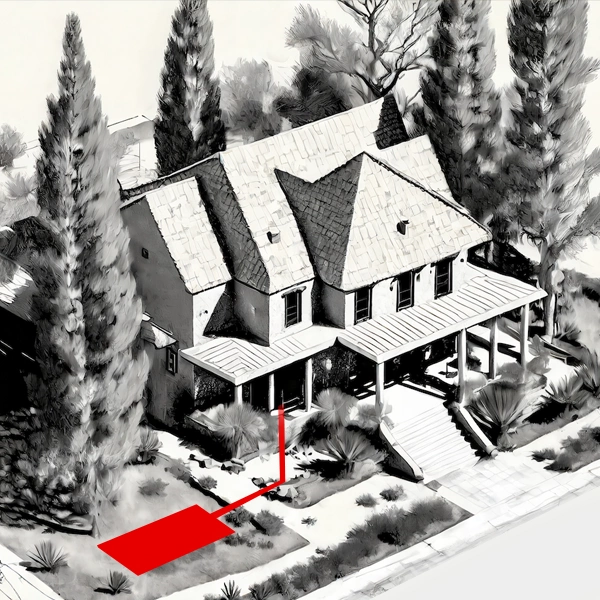
Expect basic questions about your property, septic system (age, repairs, water usage), and location (inspector finds tank or uses a tank finder).
Step 2: Visual Assessment
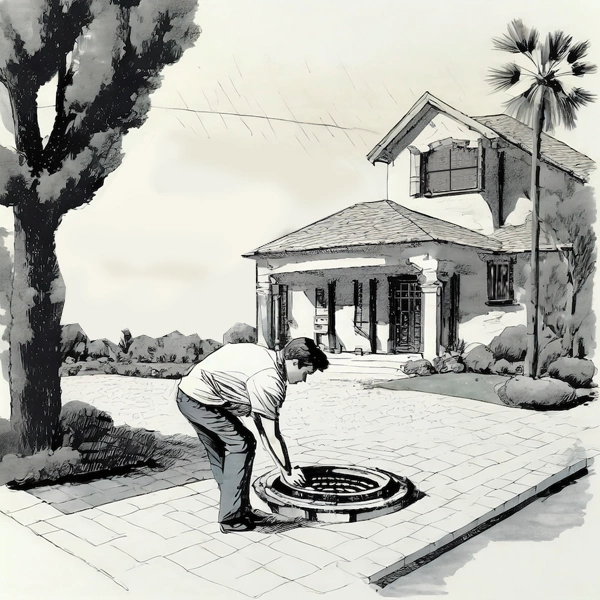
The inspector pops the lid on the tank for a visual check: levels, sludge, cracks, and pipes.
Step 3: Testing and Measurements

Measuring, tracing, and testing – the inspector uncovers how well your septic system handles its business.
Step 4: Pumping
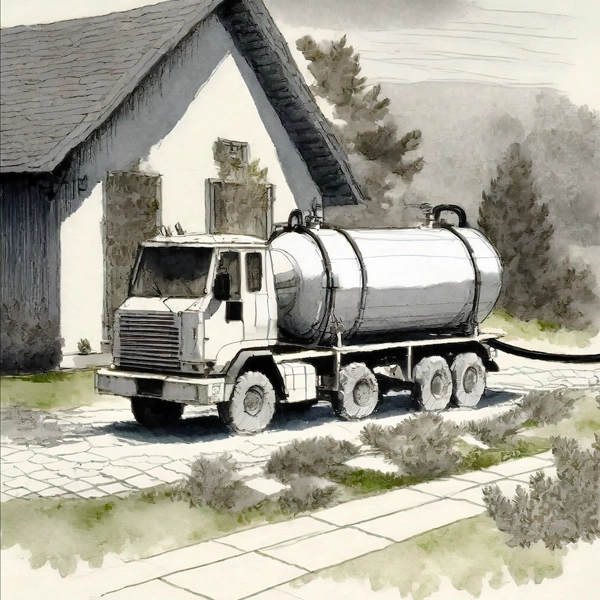
The inspector will pump out your septic tank into their tanker truck.
Step 5: Report
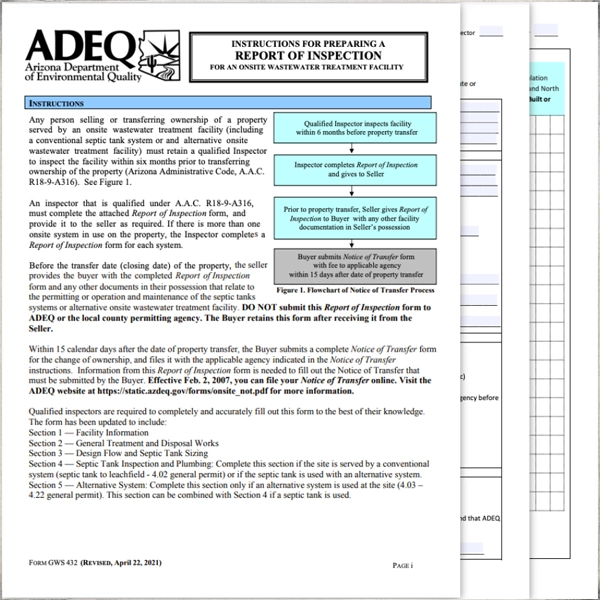
The septic system report: your post-inspection decoder ring. Unravels what the inspector saw, tested, and thinks, along with any repair recommendations.
Time Frame

A typical septic tank inspection in Arizona takes around 1-2 hours, depending on the complexity of the system and the number of tests conducted. You should expect to receive your completed ADEQ report within about 24 hours.
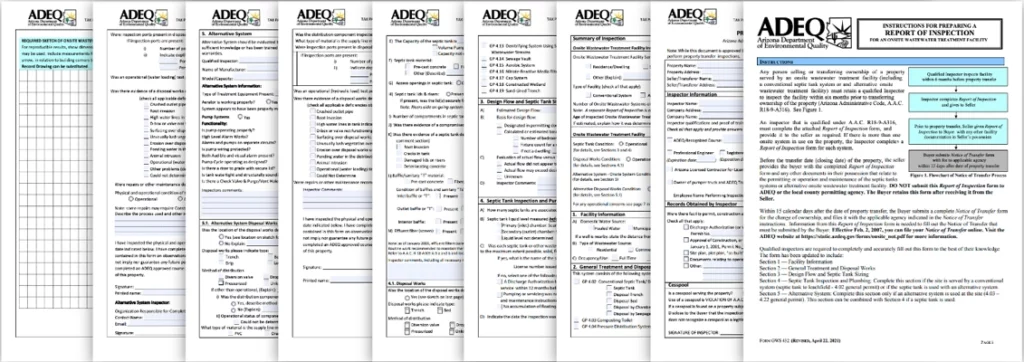
What is included in a septic inspection report?
A septic tank inspection report in Arizona is a detailed document outlining the condition of your septic system. It will typically include the following 6 items:
1: General Information

The Who, What, Where & When: address, owner, system specs, inspection date & inspector info.
2: Inspection Procedures

Tank access methods & test details with any inspection hurdles noted.
3: Observations & Findings

A report on the physical condition of the septic system. Tank examples: cracks, leaks, strength, levels, pipes. Drainfield examples: ponding, smells, stressed plants.
4: System Functionality

The inspector gives your system a thumbs-up or down, flags any glitches, and explains how it all affects the waste game.
5: Recommendations

Action plan based on findings: pumping, repairs, replacements, or further testing (prioritized by severity and urgency).
6: Conclusion

System health summary, Arizona compliance statement, and inspector contact for questions.
Additional Notes
The specific format and content of the report may vary slightly depending on the inspector and their professional practices.


